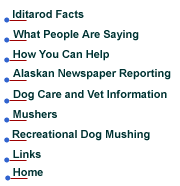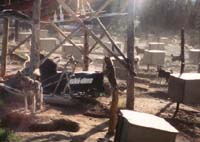

Mush with P.R.I.D.E. ignores intentional dog abuse:
"It is around one year ago today as I write
this, fewer than two weeks before the legendary 2011 Iditarod race start,
that, as a dog handler at a private kennel location in Alaska, I witnessed
the extremely violent beating of an Iditarod racing dog by one of the
racing industry’s most high-profile top 10 mushers. Be assured the beating
was clearly not within an 'acceptable range' of 'discipline'.
Indeed, the scene left me appalled, sick and shocked.
After viewing an individual sled dog repeatedly booted with full force,
the male person doing the beating jumping back and forth like a pendulum
with his full body weight to gain full momentum and impact.
He then alternated his beating technique with full-ranging, hard and fast,
closed-fist punches like a piston to the dog as it was held by its harness
splayed onto the ground.
He then staggeringly lifted the dog by the harness with two arms above
waist height, then slammed the dog into the ground with full force, again
repeatedly, all of this repeatedly."
"In an early phone conversation with Mush With Pride, it was explained
that intentional dog abuse is not addressed within their bylaws or objectives;
(they) “assume all mushers intend to provide adequate care of their dogs.”
My written requests to add direct abuse to their policy of education have
been met with more silence."
- Letter to the editor, Jane Stevens Australia
- Whitehorse Star, February 23, 2011
Mush with P.R.I.D.E. promotes killing dogs:
Mush with P.R.I.D.E.'s old guidelines not only advocated killing dogs in cases of deformity, serious injuries, sickness, or old age, but also killing dogs who did not perform well as sled dogs and were "behaviorally unsuitable" as pets. Their new guidelines say that mushers should have a rule for euthanizing a dog. According to Mush with P.R.I.D.E., "It can be as simple as: When the dog is no longer able to ____, then we will euthanize it." With this rule, Mush with P.R.I.D.E. endorses mushers killing dogs for any reason, including cases of deformity, injury, sickness, old age, not pulling, not running fast enough, not eating within the time allotted, etc.
Mush with P.R.I.D.E. says that "many sled dogs can be challenging pets." Although the organization suggests that mushers give their "surplus" dogs to a rescue organization, the reality is that many rescue organizations won't accept sled dogs. These dogs make "challenging" pets and are aggressive from living on chains. There are a small number of rescue organizations that might be willing to accept a sled dog.
Because
mushers breed many dogs to get a handful of good racers, there aren't
enough homes for all the unwanted sled dogs. Iditarod kennels acquire
and breed many more dogs than can be used in the Iditarod race. The reason
for this is simple; it is impossible to predict which dogs will become
good racing dogs or for how long a good racer will remain a good racer.
Therefore, the kennel owner maintains a large pool of dogs, and ultimately
many become unwanted or "surplus."
Mushers who live near animal control agencies can have their animals killed
at these facilities. But some mushers don't want to spend the time or
money taking dogs there, especially the many mushers who don't live close
to a facility. Some animal control agencies have euthanasia fees. Mushers
who live near an animal control agency could surrender their dogs to them
with the hope that the dog might be adopted. But this rarely happens.
Most sled dogs are aggressive and don't make suitable pets so animal control
agencies kill these dogs.
Most mushers kill their own dogs. Iditarod dogs have been shot, drowned, beaten, clubbed and dragged to death.
 |
| Dogs
run to the end of their tethers and are jerked back by their chains. [click for a larger image] |
If Mush with P.R.I.D.E. opposed debarking or devocalization, they would
say so:
Mush with P.R.I.D.E.'s old guidelines condoned debarking or devocalizing
dogs. Their new guidelines say: "If all efforts fail and you can't seem
to get a dog to be quiet, discuss the issue with a professional trainer
or your veterinarian."
Debarking is a form of mutilation involving the complete and irreversible
destruction of the dog's larynx or vocal cords. This painful surgical
procedure leaves the dog permanently defenseless and psychologically damaged.
Loneliness, boredom and distress are the top three reasons dogs bark persistently,
according to Pat Miller, CDBC, CPDT, past president of the Association
of Pet Dog Trainers. Because dogs tend to bark more in groups, it's irresponsible
to keep many dogs near neighbors, and it's cruel to devocalize them to
compensate for that poor judgment. If
Mush with P.R.I.D.E. condemned debarking, they would say so.
Here's what experts say about the cruelties of
debarking:
- Debarking is inhumane:
"'Debarking is not a medically necessary procedure,'
Dr. Klausner said. 'We think it’s not humane to the dogs to put them through
the surgery and the pain. We just do not think that it should be performed.'"
- Dr. Jeffrey Klausner is the senior vice president
and chief medical officer of Banfield, the Pet Hospital, which has more
than 750 veterinary practices across the country.
- Sam Dolnick, New York Times, February 2, 2010
"These
amputations are strictly for the benefit of the owner. They serve no therapeutic
or medical purpose. They are not surgeries in the true sense of the word.
The word mutilation is much more appropriate."
- Charles Danten, DVM, in a speech presented to the Montreal Rotary Club
on January 6, 2000, and published on Dr. Danten's website
- Debarking surgery is very dangerous:
"[Dr. Nicholas] Dodman said there is a risk
to any surgery, but operating in the vocal cord area is very dangerous
because it’s hard to administer anesthetics and there’s a lot of blood
in the area. Animals may suffer from infections, scar tissue, trouble
breathing, and hemorrhaging or aspiration pneumonia from devocalization
procedures.
'Some dogs have died in different stages (of the procedure),' said Dodman.
'This is what’s called a convenient surgery. Some surgeries are necessary.
But this is a cosmetic surgery like ear cropping and tail cropping. You’re
removing a natural part of a dog.'”
- Dr. Nicholas Dodman, DACVB is a veterinarian behaviorist of about 50
in the world.
- David Ertischek, West Roxbury Transcript, June 16, 2009
- Debarking interferes with breathing:
"Excessive tissue removal results in scar tissue
formation that can interfere with breathing."
- Letter from Christine M. Runnels, DVM, Diplomat, American College of
Veterinary Surgeons, March 7, 2005
"Dr. Gary W. Ellison, of the College of Veterinary
Medicine at the University of Florida, cautioned that the procedure can
lead to complications. He said he has had to operate on debarked dogs
after excess scar tissue built up in the throat, making it difficult for
the dog to breathe."
- Sam Dolnick, New York Times, February 2, 2010
- Debarked dogs more prone to aspirate digestive juices leading to
pneumonia:
Dr. Paula Kislak: "This surgery is especially bad,
because even under the best of circumstances animals, because of the messing
around in the throat area, that are debarked are more prone to aspirate
their own digestive juices. And when dogs are put under these intense
circumstances of racing and they're gasping all the time, they're constantly
aspirating or inhaling any vomit or digestive juice that comes up in their
mouth, and that sets them up for life-threatening aspiration pneumonias.
So that's a double whammy of the debarking."
Rob Moore: "This debarking, what is the procedure?"
Dr. Paula Kislak: "It's a surgical procedure requiring
general anesthesia. There's two actual procedures one goes from the outside
of the throat and one goes from the inside of the throat, but it's the
cutting of the vocal cords basically."
- Dr. Paula Kislak, DVM, is president of the Association of Veterinarins
for Animal Rights
-
Rob Moore hosts Animal Voices, a radio show in Toronto Canada.
- This interview was done on February 28, 2006
Mush with P.R.I.D.E. promotes deformity and disease:
In
the section entitled Exercise and Conditioning there is a subsection
entitled "Weight Pulling." Dogs are specifically bred to perform
many tasks including herding, gathering, burrowing, pulling wheelchairs
etc., but pulling exceptionally heavy loads is not one of them. Training
dogs to pull great weight goes against the dogs' natural instincts. Making
them behave so unnaturally involves abusive training that results in harm
and deformity to the dog.
Mush
with P.R.I.D.E. promotes inhumane kennel practices:
The USDA policy, under the Animal Welfare Act, rejects tethering as an inhumane practice that is not in the animal's best interests. The permanent chaining of dogs is prohibited in all cases where federal law applies. In the section entitled Confinement Systems, Mush with P.R.I.D.E. opposes this conclusion and encourages mushers to permanently tether their dogs.
Their
guidelines say: "The optimal length of the chain is somewhat longer than
the height of the pole or post." So, for example, if a musher decides
to use a four foot post, Mush with P.R.I.D.E. thinks it would be best
for him to keep the dog on a chain that's a little over four feet long.
Mush with P.R.I.D.E. doesn't say that musher should never use a two, three,
four or five foot post or pole, etc.
Their guidelines also say: "Whichever tethering method you use, space
the post so that adjacent chains can't overlap and so that dogs can't
tangle or strangle each other." Dogs shouldn't be harmed by each others
chains. But, it's important to note that the tethering systems described
by Mush with P.R.I.D.E. do not allow for normal dog interactions and severely
limit the dog's ability to exercise. The organization doesn't say that
dogs should be taken off their chains when they're not on training or
conditioning runs. It's been reported that dogs who don't make the main
teams are never taken off their chains. The USDA has determined that tethering
eliminates normal dog interactions and severely limits the dog's ability
to exercise.
The
USDA has also concluded that tethering causes many injuries. Mush with
P.R.I.D.E. ignores the abundant evidence that tethering dogs is cruel.
For information on the many ways it's unsafe and inhumane, click on HORRORS
OF CHAINING.
Mush
with P.R.I.D.E.'s Dog Health Care guidelines are unsatisfactory:
Mush with P.R.I.D.E. doesn't recommend that mushers have their dogs examined
by a veterinarian at least once a year. They don't even recommend that
sick dogs be seen by a veterinarian.
Mush with P.R.I.D.E. doesn't recommend that dogs get dental care. On About.com,
Dr. Janet Tobiassen Crosby, DVM, says: "Infected gums and teeth aren't
just a problem in the mouth -- the heart, kidneys, intestinal tract, and
joints may also be infected. The tartar and any infected areas of the
mouth contain a multitude of bacteria than can 'seed' to other parts of
the body. With regular dental care, you can prevent some of these more
serious side effects."
Mush with P.R.I.D.E. doesn't recommend that dogs be bathed. The ASPCA
website says: "The ASPCA recommends bathing your dog at least once every
three months. Your pet may require more frequent baths if she spends a
lot of time outdoors."
|
|
Mushers | Recreational Mushing | Links | Home A Kid's Thoughts |
Receive action alerts and contact SDAC: [email protected]
PO
Box 562061
Miami, FL 33256
The SDAC does not raise money and does not accept funds. Its efforts are completely volunteer-based.
© 2012 SDAC